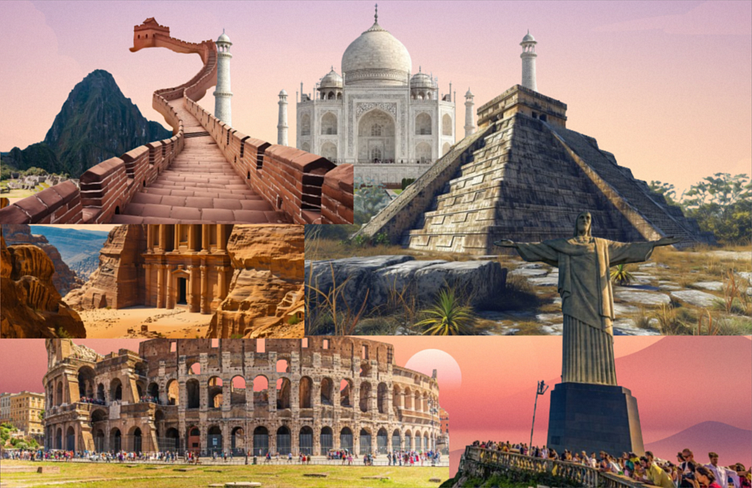New Seven Wonders of The World
The New Seven Wonders of the World were selected through a global poll organized by the New7Wonders Foundation. This initiative aimed to update the original list of Seven Wonders of the Ancient World, reflecting global heritage and cultural significance. The results were announced on July 7, 2007.
Here’s a detailed look at each of these wonders:
1. Great Wall of China (China)
Description: Stretching over 13,000 miles, the Great Wall of China was built to protect Chinese states and empires from invasions. It’s a testament to ancient engineering and labor, symbolizing the ingenuity and determination of the Chinese people.
Historical Significance: Constructed over several dynasties, particularly the Ming Dynasty, the wall also facilitated trade and communication across vast regions.
Interesting Fact: Contrary to popular belief, the Great Wall is not a single continuous wall but a series of walls and fortifications.
2. Petra (Jordan)
Description: Petra is an ancient city carved into pink sandstone cliffs by the Nabataeans over 2,000 years ago. It served as a significant trading hub due to its strategic location.
Historical Significance: Known as the "Rose City," Petra features remarkable architecture, including the famous Treasury (Al-Khazneh) and the Monastery (Ad-Deir).
Interesting Fact: Petra was rediscovered by Swiss explorer Johann Ludwig Burckhardt in 1812 after being lost to the Western world for centuries.
3. Christ the Redeemer (Brazil)
Description: This iconic statue of Jesus Christ stands 98 feet tall atop the Corcovado Mountain in Rio de Janeiro. It was constructed between 1922 and 1931.
Historical Significance: Symbolizing Christianity and peace, the statue is one of the most recognizable landmarks in the world.
Interesting Fact: Christ the Redeemer is the largest Art Deco statue in the world.
4. Machu Picchu (Peru)
Description: Located in the Andes Mountains, Machu Picchu is an Incan citadel dating back to the 15th century. It’s renowned for its sophisticated dry-stone construction and panoramic views.
Historical Significance: Often called the "Lost City of the Incas," it’s believed to have been an estate for the Inca emperor Pachacuti.
Interesting Fact: Machu Picchu was brought to international attention by American historian Hiram Bingham in 1911.
5. Chichen Itza (Mexico)
Description: A significant Mayan archaeological site, Chichen Itza features the Pyramid of Kukulkan, also known as El Castillo. The site reflects the advanced astronomical and architectural skills of the Maya.
Historical Significance: It was a major regional center and played a key role in the socio-political and economic framework of the Maya civilization.
Interesting Fact: During the equinoxes, a shadow of a serpent can be seen descending the steps of El Castillo, aligning with the serpent head at the base.
6. Roman Colosseum (Italy)
Description: The Colosseum is a large amphitheater in Rome, capable of seating 50,000 spectators. It was used for gladiatorial contests and public spectacles such as animal hunts and mock sea battles.
Historical Significance: As a symbol of the architectural prowess and social fabric of ancient Rome, it remains a powerful icon of Roman engineering and culture.
Interesting Fact: The Colosseum had a complex system of underground tunnels and rooms where gladiators and animals were held before contests.
7. Taj Mahal (India)
Description: A stunning white marble mausoleum in Agra, the Taj Mahal was built by Mughal Emperor Shah Jahan in memory of his beloved wife Mumtaz Mahal. Completed in 1653, it’s a masterpiece of Mughal architecture.
Historical Significance: The Taj Mahal is a symbol of love and one of the finest examples of Islamic architecture.
Interesting Fact: The colors of the Taj Mahal change depending on the time of day and the quality of light, appearing pinkish in the morning and golden in the evening.
These wonders reflect a diverse range of cultures, historical epochs, and architectural styles, showcasing humanity's creativity, perseverance, and dedication to beauty and functionality.
See Also
Seven Wonders of the Ancient World: Includes the Great Pyramid of Giza, Hanging Gardens of Babylon, and others, mostly now lost to history.
Seven Natural Wonders of the World: Featuring natural marvels like the Grand Canyon and the Great Barrier Reef.







